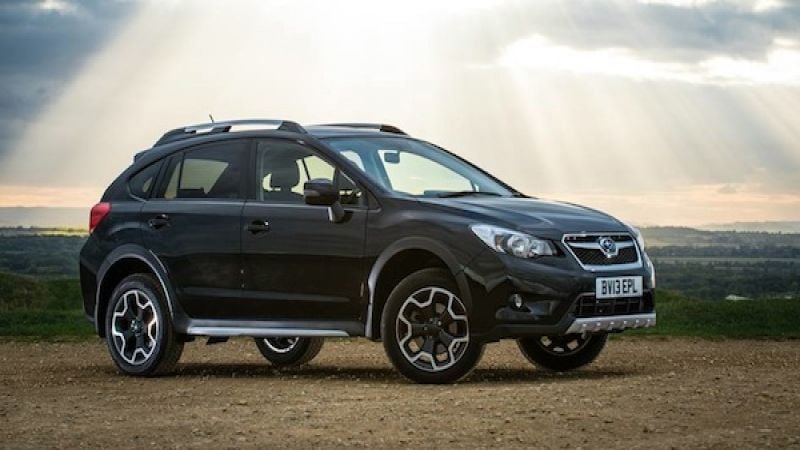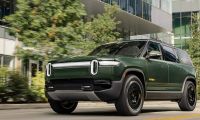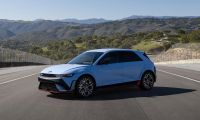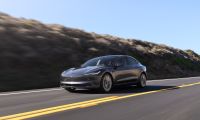Subaru is the only automaker in the UK to get two cars in the Green Car Guide top 10. Both the 2014 Subaru Forester 2.0D and XV 2.0-liter diesel models are green, get very good fuel-mileage and both are very competent off-road vehicles. The Japanese automaker makes the diesel variants in Japan, Europe and Australia and they are very green and competent. So why don’t we see these fuel-sipping diesels in the U.S.?
The 2014 Subaru Forester and XV Crosstrek, both on the Green Car Guide top 10 list, get excellent fuel mileage. Forester gets 49.6 mpg and XV 50.4 mpg on the European cycle. Both come with a 2.0-liter Boxer diesel engine that comes with 148 hp with 258 lb. ft of torque. The are smooth, powerful and have plenty of low-end torque to get the all-wheel-drive multi-use vehicles through any driving situation on-road or off-road. XV came in at number 4 on the list, Forester was number 10.
Heres’ what Green Car Guide for 4x4's had to say about the Subaru XV diesel. “Subaru has a strong track record in the area of 4x4s, with a number of World Rally Championships under its belt thanks to the Impreza. The latest Subaru XV is very competent in the rough stuff, and it can also manage 50.4mpg.” About the Forester, here was their comment. “Yes it’s another Subaru. The Forester has grown and offers more space than the XV, it’s capable off-road, and can achieve good real-world economy.”
We know the benefits of a diesel engine, but why do other sports enthusiasts get the benefits of the diesel in the Forester and XV Crosstrek but not those in the U.S.? Here in the U.S., buyers have been asking for Subaru to bring a diesel variant to North American shores for years now. Why isn’t Subaru importing these diesel variants in to the U.S. market?
Part of the reason Subaru doesn’t offer a diesel in the U.S. is because of economics. Historically, there’s always been a higher demand for gasoline here. The federal government taxes every gallon of fuel sold, and our tax system is biased toward gasoline, making it cheaper to buy than diesel. It’s the exact opposite in Europe and in other global markets like Australia. Diesel is cheaper to buy than “petrol”. In the U.S., gasoline is much cheaper than other parts of the world and is the popular choice. It’s hard to convince consumers to pay an extra $5-7,000 for a diesel vehicle, and then ask them to pay more at the pump for diesel fuel.
Another factor is the way U.S. regulations for diesels are different than Europe. U.S. regulations only allow a diesel to emit 0.07 grams of NOx per mile, making compliance much more costly for an automaker. European emissions standards allow a diesel to emit up to 0.29 grams of nitrous oxide (NOx) per mile.
The third factor why the U.S. gets left out of getting the Subaru Forester and XV Crosstrek diesel variants, is that it’s expensive for a manufacturer to get their diesel engine certified here in the U.S., which again adds to the cost of that diesel car. To meet U.S. regulations, automakers are required to use expensive after-treatment systems that in some cases inject an aqueous urea solution to handle the NOx. The added expense of course means an even longer payback period for the consumer.
How soon will we see a Subaru Forester and XV Crosstrek diesel in the U.S.? Don't hold your breath. Subaru will not likely spend the money for certification when many U.S. buyers aren’t willing to pay extra for that Subaru Forester or XV diesel. 2014 Forester and XV Crosstrek 2.0D diesels were both voted Green Car Guide for 4x4's top ten list because they are powerful and efficient engines. We in the U.S. will have to stick with our gas models.












Comments
I would have loved to
Permalink
I would have loved to purchase a Subaru Diesel, but I am quite happy with my VW Jetta TDI. The author seems to be unfamiliar with real world Diesel sticker price. A Jetta TDI value edition is only about $2000 more than the 1.8T gas. And with real world mileage 20% to 50% better than gas engine, it's cheaper at the pump too.
What is cheaper at the pump
Permalink
In reply to I would have loved to by TDIdriver (not verified)
What is cheaper at the pump too? Diesel has been 60 cents more when I look.
Sure, it's a bit more
Permalink
In reply to What is cheaper at the pump by Jon Robert (not verified)
Sure, it's a bit more expensive by the gallon, but you end up buying so much less. Especially for highway driving, I can get 50mpg with my Jetta Wagon. Since I drive a lot of highway, I save a ton of money. Also, diesel engines require far less maintenance than gasoline engines, are sturdier and will last longer than gasoline engines. The maintenance schedule of a Jetta Wagon ends up being significantly less expensive than the maintenance schedule of the gasoline powered model.
Diesel prices vary alot in
Permalink
In reply to What is cheaper at the pump by Jon Robert (not verified)
Diesel prices vary alot in Los Angeles, just today i saw it for $3.69 at a Shell Station and then just 1 mile down the road it was only $2.99 at Chevron, even cheaper than most of the $3.25 gasoline! I believe clean diesel will gain plenty of momentum very soon in the States. Diesel will definitely boost mpg requirements especially the EPA's 54.5mpg by 2025. In LA Hybrids rule, and theyre great the pros in a hybrid are the city/ highway spread is relatively close and similar while diesels tend to have wider margins between city/highway. But Diesels are great because they dont compromise power and acceleration by giving extra torque that hybrids often lack.
I would buy a diesel Forester
Permalink
I would buy a diesel Forester in a heartbeat. And I bet a zillion other loyal Subaru owners here in the PacNW would too. But it's hard to imagine our obstructionist congress allowing the changes in the tax code that would make that ever a possibility.
Congress? The tax code?
Permalink
In reply to I would buy a diesel Forester by Fred Lifton (not verified)
Congress? The tax code? Please- ask the Sierra Club, Friends of the Earth and the EPA why we can't have them? Yjey'll all say the same thing: They're dirty and contribute to "global warming" with their stinky petroleum byproducts.
Part of the problem is miss
Permalink
In reply to Congress? The tax code? by Chris Philips (not verified)
Part of the problem is miss information such as this. The reality, if one cares to dive into the actual facts related to the comparison of gas vs. diesel emissions is that diesel is actually cleaner. Here is an excerpt from a NYtimes article but all research reports the same (not that this is rocket science, it's basic math and very tangible).
As for greenhouse gases, there’s no getting around the fact that most diesel fuel is derived from oil — a huge contributor to global warming at every stage of its lifecycle. But the Energy Information Administration reports that on a “well to wheels” basis — a measure incorporating emissions over the fuel-oil lifecycle, from its withdrawal from the well to refining and ultimately to its combustion in a car’s gas tank — greenhouse gas emissions from diesel cars are roughly 15 percent lower than those arising from comparable gasoline cars.
I would buy the Forester in a
Permalink
I would buy the Forester in a heart beat. I would upgrade everything to show my appreciation. =)
Over 7,500 people on FB have
Permalink
Over 7,500 people on FB have shown they want diesel on the "Bring Subaru Diesel to the US!" page.
We own 2009 Forester, we
Permalink
We own 2009 Forester, we will be replacing our second auto in 2015 if Subaru had the diesel Forester avail. We would purchase one as our second. At this time I,m leaning towards the VW Passat TDI mileage is more important now.
I have a 2015 Forester (my
Permalink
In reply to We own 2009 Forester, we by John Fisher (not verified)
I have a 2015 Forester (my 5th Subaru) and a 2013 Passat TDI SEL Premium. The Passat is a great choice if you want a diesel. I get 38mpg driving around town and 48mpg on a highway trip. But if Subaru introduced a diesel Forester or Outback by 2016, I would buy one in a heartbeat.
dear subaru executives in
Permalink
dear subaru executives in charge of the north american continent vision:
please resign.
sign,
everyone in north america.
VW just announced the new TDI
Permalink
VW just announced the new TDI Golf Sportwagen will be offered in the U.S. sometime in late 2016, partly to compete with Subaru. With Subaru's improved fuel economy in r gas models it will be interesting to see if the improved fuel economy in the VW'so is enough to merit over the proven AWD and reliability of the subaru. Our 2004 TDI Jetta Wagon is about due to get upgraded but I a willing to wait a year to see how things are shaking out.
After owning FOUR Subaru
Permalink
After owning FOUR Subaru vehicles (WRX, Outback XT, Outback, STI) I got tired to wait for a diesel to come and switched to BMW and Jeep diesels. My last remaining Subaru will be also replaced with VW TDI in the next few years if Subaru diesels don't come
Diesel XV is my dream! There
Permalink
Diesel XV is my dream! There is a serious lack of diesel non luxury 4x4s in the US. Subie would dominate the market!! And I would be able to get a #4 Subaru badge :(
Instead of spending the money
Permalink
Instead of spending the money to get diesels approved in the US, Subaru wasted it developing a half-baked hybrid for the XV. Since the only extra electricity generation comes from braking, highway mileage is the same as the regular gas XV. Factor in extra cost ($5,000), weight, complexity and loss of the spare, this hybrid really is pathetic.
Why should Subaru spend the
Permalink
Why should Subaru spend the energy to market the Forrester Diesel in the US when they sell all the gas models they can make. US consumers are less sophisticated than other markets, they will accept less so they are offered less. How sad! The article incorrectly lists NOx an nitrous oxide, which is N2O.
Hi wen is it coming to canada
Permalink
Hi wen is it coming to canada
I'd buy one too. But it's
Permalink
I'd buy one too. But it's supply and demand... Subaru NA is waiting for a pent-up demand (as exhibited here and elsewhere) to give them an excuse to artificially jack up prices and "make the economics work." Same thing as BMW did a few years ago with their marketing push to make diesel cars in the U.S. (German ones, no less!) seem like a "fresh, new idea." *cough, Volkswagen and Mercedes, not to mention Volvo and OLDSMOBILE in the '70s, for heaven's sake, *cough**
VW will take market away from
Permalink
VW will take market away from Subaru in 2016 with their diesel sportwagon all wheel drive. Subaru had better wake up.
sadly, VW has announced that
Permalink
In reply to VW will take market away from by Bob (not verified)
sadly, VW has announced that the Golf/SportWagen variant w/4motion cannot have a TDI/Diesel engine ... or conversely, the TDI/Diesel Engine cannot have 4motion ...
I want a diesel Outback!
Permalink
I want a diesel Outback!
I have a 2014 Diesel Outback
Permalink
In reply to I want a diesel Outback! by Clifton Swanson (not verified)
I have a 2014 Diesel Outback as I work in Germany and can say that I think it really is great a all-around vehicle. I have been driving powerful diesels (nonetheless only 2.0-2.2 liter engines) for their great fuel economy, torque, and longevity in Europe for years and have about 30k mi on this 2.0D six speed outback. I use it to transport the family safely and comfortably as well as a daily commuter. Since I am in Germany and travel about 90 miles each day on the Autobahn, I can tell you that I drive this outback every day over 120 mph safely (driving such speeds is standard on the Autobahn) through tight turns etc. on my way to Frankfurt and it is surprisingly agile for such a vehicle. I agree that this would be a great choice back in the U.S. l if Subaru decides it is worth the investment to introduce the 2.0D into the U.S. market.
I have a 2014 Diesel Outback
Permalink
In reply to I want a diesel Outback! by Clifton Swanson (not verified)
I have a 2014 Diesel Outback as I work in Germany and can say that I think it really is great a all-around vehicle. I have been driving powerful diesels (nonetheless only 2.0-2.2 liter engines) for their great fuel economy, torque, and longevity in Europe for years and have about 30k mi on this 2.0D six speed outback. I use it to transport the family safely and comfortably as well as a daily commuter. Since I am in Germany and travel about 90 miles each day on the Autobahn, I can tell you that I drive this outback every day over 120 mph safely (driving such speeds is standard on the Autobahn) through tight turns etc. on my way to Frankfurt and it is surprisingly agile for such a vehicle. I agree that this would be a great choice back in the U.S. l if Subaru decides it is worth the investment to introduce the 2.0D into the U.S. market.
I stopped holding my breath
Permalink
I stopped holding my breath waiting for a diesel Subaru, so I purchased a used diesel Jeep Liberty instead. Better mileage than my 2006 Outback, true full time selectable 4x4 (not that the Subaru was lacking), double A arm front suspension instead of McPherson strut, minimum ground clearance doesn't change when loaded, and 5000lb towing capacity. I just wish the sunroof was as big as the Subie's.
Diesel wasn't ALWAYS more
Permalink
Diesel wasn't ALWAYS more expensive than gasoline in the US. I remember a time not too long ago when diesel was MUCH cheaper that gasoline. It was around 2003 when the prices made a major switch (right around the time I bought my VW Golf TDI ironically) I've been given a lot of "excuses" as to why. I was told our diesel refining capacity isn't what it used to be? I was told it all has to do with the additional taxes added to diesel fuel now? Additional requirements placed on low sulfur and emissions diesel fuels that cost more to refine? I don't know exactly what happened in just over the past decade but I feel like we've been bamboozled.
Creative post - I Appreciate
Permalink
Creative post - I Appreciate the details - Does someone know where my business would be able to get access to a blank a form version to fill out ?
The Crosstrek would
Permalink
The Crosstrek would definitely come alive if it were diesel. Not only would it get better gas mileage, but that giant leap in torque makes it considerably more useful for the intended customer! 148hp / 145tq isn't enough for the outdoors; but, 148hp / 258tq is great. For comparison, that's the same torque you get from a WRX. Granted, it won't be nearly as fast, but it's potent enough to do what you need done. I'd buy it in a heartbeat.
although it's true about the
Permalink
although it's true about the gallon of diesel being equal to the gallon of premium on average, the author forgot to calculate how many gallons of gas one would need to purchase, even 87 octane, to obtain the same fuel mileage as a diesel. although many new petrol cars are boosting new EPA mileage, rarely does one achieve it. being a diesel technician and an owner of a 2014 Cruze Diesel, it's hard to beat 57 mpg on Highway and 42 city. Bring it Subaru and it will sell!
Has any one comments about
Permalink
Has any one comments about Subie diesel cranksfaft problems. I heard about possible broken crankshafts for earlier models 08 - 10. Have You any info about later models???
In my use were: Leone 86, Legacy 94, VIVIO 96, SVX 94, Forester 2,5 xt 06, and now Legacy 2011 with replaced diesel from 2013 model.
Thanks a lot!!!!